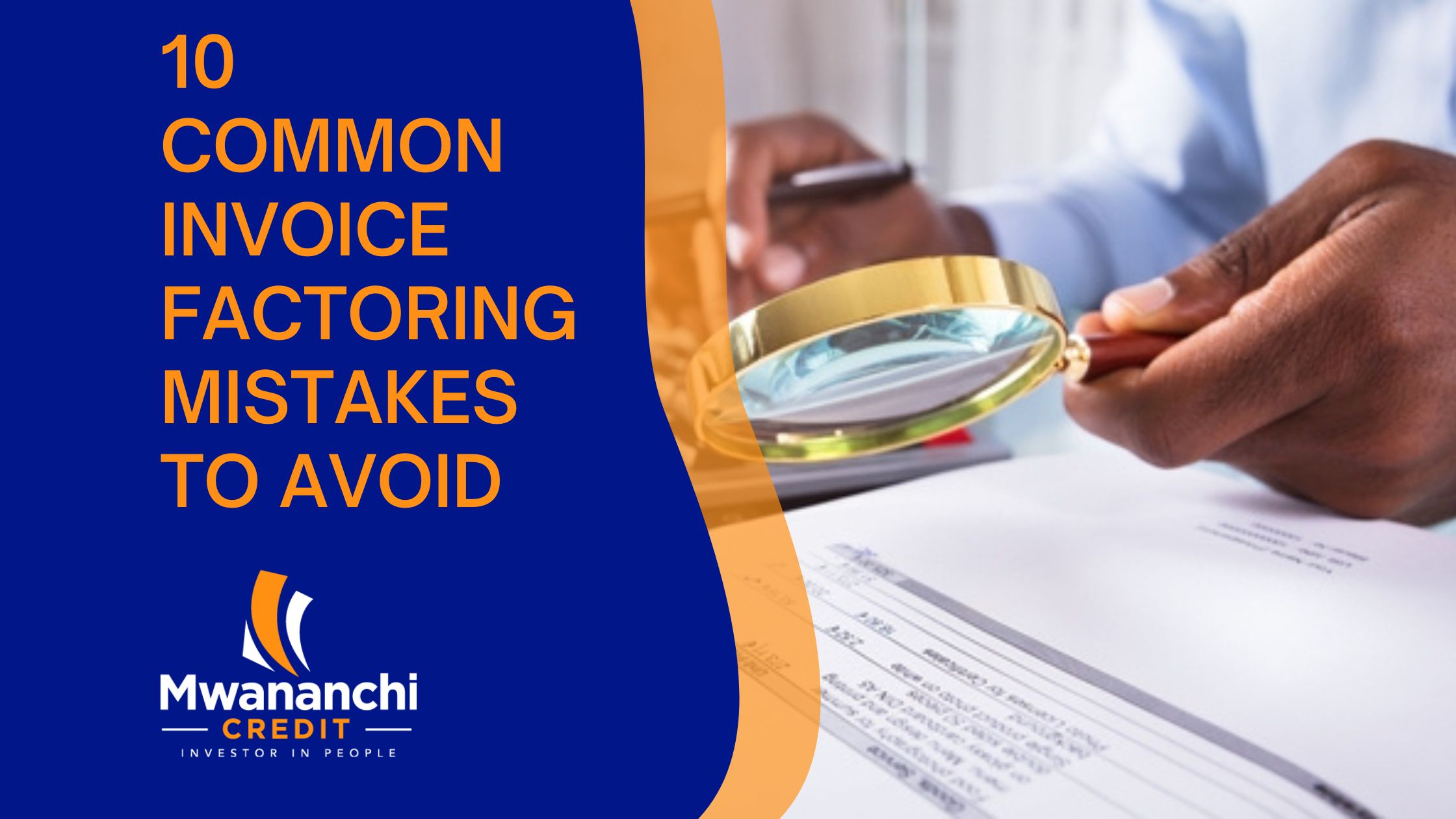Factoring invoices is an alternative funding solution for businesses that need cash now and can’t wait for their clients to pay them. Invoice factoring goes beyond the usual invoice financing and invoices discounting services: it is a partnership between two parties based on trust, transparency, and loyalty. The factoring company trusts that you will be able to collect your outstanding invoices from your customers, while you trust the factor so they will take over the payment process on your end.
The primary benefit of invoice factoring is having cash in hand faster, but to get this advantage, you need to know about common mistakes made by businesses when negotiating this type of deal. Here are 10 things you should watch out for when signing a new contract with a new factor. If you recognize yourself in any of these statements, we recommend reading this article again before moving forward with an agreement.
1. Failing to send an invoice
This is the very first step in the whole process. It may seem too obvious but several companies make this mistake. The invoice is a very important document: it is your proof of work, and it shows the timeline of your services. An invoice is the best proof that your client received your services. If you don’t have one, the factor won’t be able to confirm that you provided your services.
If you don’t send an invoice, you won’t be able to get paid for your services – plain and simple. If your invoice is for your client, the factor will pay you only after the client pays the factor. No matter how trustworthy your client is, it is always better to have an invoice to prove your services.
2. Sending the invoice to the wrong company/person
While not sending an invoice at all may not get you any money, sending the invoice to the wrong person can delay your payment. This typically happens when you are billing a large enterprise with lots of staff and several departments. It is easy to get confused about who receives invoices in such organizations.
Sending an invoice to the wrong company is entirely rare, but not unheard of. This can be disadvantageous in several ways, but most importantly, it can lead to the revelation of sensitive information to strangers or competitors. This can not only reflect poorly on your level of professionalism but can also escalate into potential legal risk.
3. Failing to inquire about the upfront advance percentage
Invoice factoring gives you an advance in exchange for your unpaid invoices. However, usually, you receive about 80% of the invoice amount upfront instead of the entire amount. The pending amount is paid when the customer pays the invoice. This amount does not include the factor’s fees. You need to ensure that the initial amount you receive is adequate to fund your business operations. If it isn’t, consider other options, like a short-term loan, to get working capital.
4. Not reading the fine print carefully

Every invoice factoring contract is different – there are no two contracts that are the same. It is important to read the fine print carefully so you understand what you are getting yourself into. Otherwise, you could be missing out on benefits that are crucial for your business. Some of the things you should read carefully include interest rates, minimum monthly payments, fees, late payment fees, cancellation fees, and contract length.
If you fail to read the fine print carefully, you could end up paying more than you should or miss out on benefits that would make your business grow faster. For example, in some invoice factoring companies like Mwananchi Credit Limited monthly fee ranges from 1%-3% for having an open account with us. It is important to know about this fee so you can decide whether it is worth it or not.
5. Misdirected payments
Misdirected payments happen when the factor sends your payments to the wrong bank account. This is a very common mistake, and it can be easily avoided by following a few simple steps:
Before the first payment, make sure you have the factor’s bank account information.
Always confirm the factor’s bank account information before accepting the first payment. This is crucial; otherwise, the factor will send the payment to the wrong account.
When you receive a payment, make sure you confirm the payment with the factor. Some factoring companies email a confirmation link to the client, but they send a confirmation to the business. It is important to confirm the payment with the factor so you know it arrived.
6. Submitting local purchasing order
Many businesses make the mistake of submitting an LPO to their clients and then asking their clients to pay the invoice and the LPO at the same time. This approach is not efficient: it is better to submit an LPO and then use an invoice factoring company to get paid for your services. Using an invoice factoring company is beneficial for several reasons:
- You can get your money faster.
- You don’t have to chase your clients for payment.
- The invoice factoring company takes on the risk of not getting paid by your clients.
7. Not differentiating between invoices and contracts
There are several things you should watch out for when signing contracts with clients. One of the most common ones is differentiating invoices from contracts. Contracts are agreements that show the commitment to buy products and services. Invoices, on the other hand, are documents that show that the products and services have already been provided. You can factor in an invoice, but not a contract. It should be included only as a supporting document for your factoring application, in case it needs to be verified. Differentiating between invoices and contracts is very important to avoid any confusion.
8. Confusing invoice factoring and invoice financing
These two terms are very similar and sometimes confused, but they are not the same thing. It is important to understand the differences between the two so you can make a better decision.
What is invoice financing?
Invoice financing, also known as invoice discounting or accounts receivable financing, refers to borrowing money against your outstanding accounts receivables. A lender gives you a portion of your unpaid invoices, potentially as much as 80% upfront, in the form of a loan or line of credit.
Once your client pays the invoice, you’ll pay the lender back the amount loaned plus fees and interest. With invoice financing, your business is still responsible for collecting outstanding money owed by your clients.
In some cases, the invoice financing company will sync up with your accounts receivable systems behind the scenes. When your customer pays the invoice, the financing company might automatically deduct its fees before forwarding you the balance
What is invoice factoring?
With invoice factoring, also called accounts receivable factoring, you sell your outstanding invoices to a factoring company at a discount. The company will pay you a percentage of the invoice amount up front and then assume responsibility for collecting the full amount.
Once the company collects the full repayment from your customer, they’ll send you the difference, minus the agreed-upon fees. Unlike an invoice financing arrangement, with invoice factoring, your clients make their repayment directly to the factoring company instead of repaying you.
Similarities between invoice factoring and invoice financing:
- Both invoice factoring and invoice financing offer companies a way to get paid faster.
- With both options, the company gets paid before the client pays them.
Differences between invoice factoring and invoice financing:
- Invoice factoring is a one-time deal, whereas invoice financing is a continuous relationship.
- Invoice factoring is available for a limited amount of time, but invoice financing is available for as long as you have contracts.
- Invoice factoring is a percentage of your outstanding invoices, whereas invoice financing is a percentage of your outstanding contracts.
- Invoice factoring is an alternative funding solution, whereas invoice financing is not a funding solution at all.
- Invoice factoring is a partnership between two parties based on trust, transparency, and loyalty, whereas invoice financing, is a business relationship based on interest rates, costs, and fees.
Pros of invoice financing and factoring
Good for business-to-business companies.
Both invoice financing and invoice factoring are ideal for B2B businesses that have cash flow issues due to unpaid invoices. You can use either of these types of funding to quickly access capital before your customers pay their invoices.
Flexible requirements.
Compared to other types of business loans, invoice financing and invoice factoring can be easier to qualify for, even if your business is a startup or you have bad credit. Lenders may prioritize the value of your invoices and your customers’ payment history when evaluating your application.
Cons of invoice financing and factoring
Can be expensive.
Although companies can charge fees in different ways, you’ll typically pay a percentage of the value of the invoice — anywhere from 1% to 5% total per month — for either invoice financing or factoring. When you calculate these fees into an annual percentage rate(APR), you’ll find that they can be expensive.
Relies on customer payments.
With both factoring and invoice financing, the amount you pay in fees ultimately depends on how fast your customers pay their invoices. This structure makes it difficult for you to estimate the cost of financing upfront. Plus, if your customer pays late or misses a payment, you may face late or additional fees. And if your customer doesn’t pay at all, in most cases, you’re held responsible for the debt. Some factoring companies do offer non-recourse factoring, in which the company accepts the loss if your customers don’t pay. However, this type of financing, which isn’t usually offered with invoice discounting, is typically a more expensive option.
9. Choosing invoice factoring for every financial need
Some companies try to use invoice factoring for every financial need. For example, if a company has a high inventory, they try to use invoice factoring to get rid of the inventory. It is not a good idea to use invoice factoring for any financial need you have. If you have inventory, you have bills that need to be paid; this is different from an invoice.
Invoice factoring is not a funding option for all businesses, but it works well for many businesses. It is important to do your homework and research before deciding on the best funding option.
Invoice factoring is not a perfect solution, but it is worth considering if you need short-term financing.
Invoice financing vs. factoring: Which is right for my business?
Invoice factoring is a good option for businesses that don’t mind giving up control of their invoices and allowing the factoring company to collect payments from customers. It can be particularly useful for smaller businesses that don’t have resources to devote to following up on invoices.
If you’re a new business or have bad credit, factoring may be easier to qualify for as it relies more heavily on the credit profiles of your customers. However, it may also have higher fees.
Invoice financing, on the other hand, is a better option for businesses that want to maintain control over their accounts receivable. If you have a strong relationship with your customers and can collect your outstanding invoices quickly, invoice discounting can be a particularly fast and even affordable financing method.
What are the companies that offer invoice discounting?
Mwananchi Credit Limited offers invoice discounting to customers across all counties in Kenya. This allows you to sell outstanding invoices to a lender, who then gives you a cash advance based on a percentage of the invoice’s value, just like with any other sort of invoice financing. The lender pays you the remaining sum less their charge when your customer has paid the invoice.
10. Delaying the Invoice
Do you often wonder about the best time to send out the invoice to a client? The ideal time for this is as soon as you complete the project or deliver the product. If you wait any longer than a couple of days, sending out the invoice may skip your mind entirely. Further, also bear in mind that the client’s payment cycle may differ from yours, which may cause your payment to be delayed.


